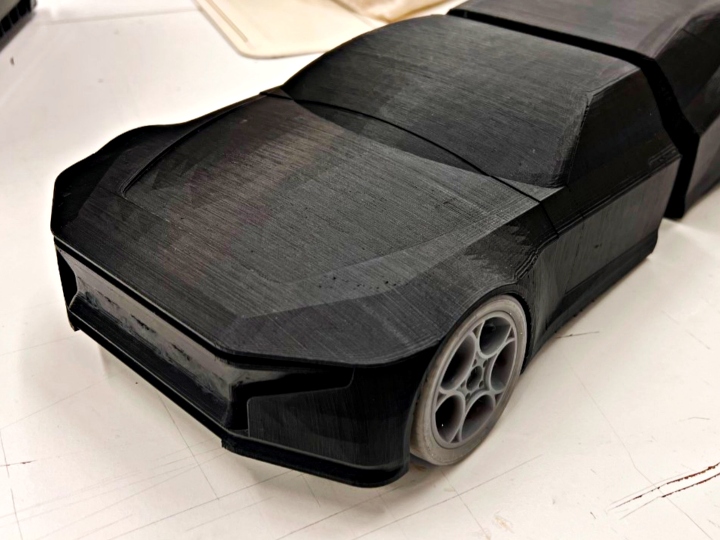
University of Houston students are competing to design the next generation of luxury electric vehicles as part of their coursework at the Gerald D. Hines College of Architecture and Design.
Mark Kimbrough and Jeff Feng, co-directors of the industrial design program, offered students enrolled in junior- and senior-level classes the opportunity to participate in the design competition while still gaining class credit. Seniors, who designed the vehicle exteriors, paired up with juniors, who created the interiors, to form eight teams.
“Through our program, students in the past have designed other modes of transportation, such as bicycles and electric scooters, but we’ve never done a car,” said Kimbrough, instructional associate professor of industrial design. “The timing for this project is amazing, because the electric vehicle industry is moving to Texas. This is an opportunity to position our design program and be ready for the industry.”
The students’ creativity and innovation will be on display during an exhibition opening on Friday, Dec. 2 at the Mashburn Gallery in the Hines College from 5 - 8 p.m., where the winners will be announced.
The competition was made possible through sponsors Photon Auto, TexPower EV Technologies, and IQP (Integrated Quantum Photonics). Photon Auto, based in Houston, is developing a new electric vehicle with a range of 500+ miles and is equipped with lidar systems, which send pulses of laser light to determine the presence, shape and distance of objects, and advanced crash prevention systems.
TexPower develops cobalt-free high-energy cathode materials for lithium-based batteries for premium electric vehicle markets and special applications. Additionally, it is working on a new 350 watt hour per kilogram battery to power Photon Auto electric vehicles.
IQP has invented and patented a new type of photonic sensor with aims to transform the industry and make electric vehicles safer.
“The competition will challenge student designers to think critically about how to respond to rapidly advancing electric vehicle technologies, which revolutionize the concept of driving,” said John Houghtaling, CEO of Photon Auto.
Students will be judged based on innovation, originality, quality of aesthetics and quality of execution. Scaled 3D printed models of the exterior designs will be on display. These will serve as study models for judges to understand the form of the design. A more detailed look at the vehicle exteriors will be provided through large, high-resolution digital renderings. Interior designs will also be presented through digital renderings.
The first-place winner will receive $1,000 and the opportunity to intern with Photon Auto.
Other notable attendees at the event include indiGO Auto Group, a luxury vehicle dealership in Houston, and Evolve, a non-profit promoting electric transportation in Greater Houston.
Fostering Human Connection
Senior Ethan Hunter and junior Danny Blacker designed a sedan that offers a throwback to the Delorean – aggressive, sturdy and sleek.
“It’s still very early in the life of electric vehicles,” Hunter said. “Electric vehicle design is still pretty open to interpretation, and you can try new things. For example, traditional gasoline-powered vehicles have a giant engine in the front, therefore there is a need for a grill. With electric vehicles, the motors are small, so you can keep them down low in the car.”
Smaller motors present numerous possibilities from a design standpoint. The extra room in front could be converted into storage space, which is what Hunter and Blacker decided to do. They also used the additional space to foster human connection in the vehicle.
“We’ve attempted to minimize, or even hide, screens and other distractions that would take away from interaction with other passengers,” Blacker said. “In addition, we’re using a lot of wood, metal accents and wide open views to connect with the world inside and outside the vehicle. We’ve prepared for when autonomous driving becomes more prevalent by allowing the front passengers to pivot their chairs toward each other while in motion to enhance connection.”
The project ultimately diversifies the students’ portfolio as they add the experience to the skills they acquired through UH’s industrial design program.
“I’ve always had the desire to solve problems around me, but for the longest time I never knew how that equated to a profession in the ‘real world,’” Blacker added. “Once I learned about industrial design and not only the breadth of problems industrial designers solve, but how they were solving it, I just knew it was a community that I had to be a part of. That intersection between engineering and art is a rewarding and beautiful place to be.”
Immersing Before Innovating
Kimbrough and Feng wanted the project to be as immersive as possible for students, so to inspire them, they visited indiGO Auto Group’s Houston dealership where students familiarized themselves with the exterior and interior of luxury vehicles like Lamborghini, McLaren and Bentley.
“The representatives gave us very detailed introductions to the exteriors and interiors,” Feng said. “Through that exposure, students gained understanding and experience. Sometimes they have to touch the controls, feel the seat and examine the shapes and details so they have an idea of what to create.”
The students’ designs may become real-life cars one day, depending on the interest of the sponsoring companies.
“The high-quality work from this project will enhance students’ competitiveness,” Feng said. “This will give them an extra edge against other recent industrial design students.”